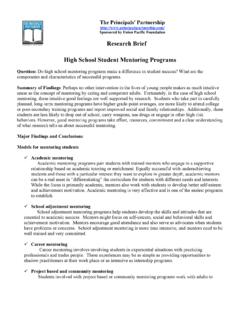Transcription of Safe Routes to School Guide
1 safe Routes to School Guide Student Drop-off and Pick-up Created February 2007. SafeRoutes National Center for safe Routes to School This Guide was developed by the Pedestrian and Bicycle Information Center (PBIC) with support from the National Highway Traffic Safety Administration (NHTSA), Federal Highway Administration (FHWA), Centers for Disease Control and Prevention (CDC) and Institute of Transportation Engineers (ITE). This Guide is maintained by the National Center for safe Routes to School at Contents Student Drop-off and Pick-up 7 1. What's Wrong With This Picture?.. 7 2. Student Drop-off and Pick-up 7 4. Encouraging Walking, Bicycling and 5.
2 Curb Striping and Other Pavement 7. 8. Separating Motor Vehicles From Pedestrians and 8. Drop-off and Pick-up 10. Assistants to Help students In and Out of 11. Off-site Queuing 11. Temporary Street Closures and One-way 12. Temporary Use of School Grounds as a Drop-off and Pick-up 13. 13. Monitoring and Enforcement of Drop-off and Pick-up 14. Overview T he purpose of a safe Routes to School (SRTS). program is to encourage and enable more children to and encouragement solutions to these problems. The purpose of improving the drop-off and pick-up process walk and bicycle to School safely. Communities tailor is to increase the safety and attractiveness of traveling a combination of engineering, enforcement, education to and from School on foot or by bicycle.
3 The drop-off and encouragement strategies to address the specific and pick-up process, as with all components of a SRTS. needs of their schools. This includes the walk or bicycle program, requires coordination with local government journey to and from School as well as the drop-off and officials, law enforcement, School officials, parents and pick-up process of children at School who are transport- the general public. ed by motor vehicle. The drop-off and pick-up process must be safe and efficient for students and parents arriv- Improving the drop-off and pick-up process will: ing by bus or private motor vehicle, as well as those who Increase safety for everyone in route to and from arrive on foot and bicycle.
4 School , as well as on School grounds. Employ engineering, enforcement, education and Some parents are reluctant to allow their children to encouragement strategies. walk or bicycle to School due to the traffic congestion Require a site-specific application of strategies;. and perceived traffic danger during student arrival and each School will have its own set of limitations and dismissal. This often results in more parents driving their opportunities. children to School which adds to the extra congestion and safety problems at the School , creating an increas- ing cycle of more traffic problems and less walking. By improving the drop-off and pick-up process, traf- fic conditions become safer for all, including pedestrians and bicyclists.
5 Better organized and safer traffic condi- tions will ease the concerns of parents, and make them more willing to allow their children to walk or bicycle. This chapter will help readers identify problems associ- ated with the drop off and pick up of students at School , and identify engineering, enforcement, education Casselberry, Florida. Mike Cynecki David Parisi Orangewood Elementary School , Phoenix, Arizona. Rogers Elementary School , California. Student Drop-off and Pick-up 7 . What's Wrong With This Picture? T here are many ways that a drop-off and pick-up zone can become dangerous for children. The next several images illustrate a variety of situations that are chaotic and potentially unsafe.
6 What's wrong with these pictures? . David Parisi David Parisi This drop-off and pick-up site employs some useful strategies including striping, signs and enforcement, but it is not working. The pictures show the chaos along the curb and in the street. Note the double parking, erratic behavior and dangerous mix of pedestrians and motor vehicles. what's wrong with this picture? . what's wrong with this picture? . David Parisi David Parisi Motor vehicles are parked in the School crosswalk. Motor vehicles are driving in the wrong direction. Children are exiting motor vehicles in the middle of the street. Student Drop-off and Pick-up 7.
7 What's wrong with this picture? . what's wrong with this picture? . David Parisi David Parisi This small child is running across a busy parking lot The driver of this motor vehicle is making a U-turn in unaccompanied. the School drop-off and pick-up zone. what's wrong with this picture? . what's wrong with this picture? . David Parisi David Parisi Motor vehicles are parked along the NO STOPPING The School utilizes orange cones to mark the drop-off zone when they should not be. and pick-up lanes and a driver still performs an illegal U-turn. Student Drop-off and Pick-up 7 . Student Drop-off and Pick-up Tools W hen assessing the drop-off and pick-up process, activity on School grounds (on-site), as well as activity in the area surrounding the School (off-site), must be considered.
8 These images depict an on-site drop-off and pick-up process that is orderly; motor vehicles are approaching single file and releasing students directly to the sidewalk in the designated drop-off zone. David Parisi David Parisi But off-site, on a street near the same School , the process is chaotic. Notice the backed-up street, delaying commercial vehicles, School buses and parents wishing to drop off children. Such situations are often accompanied by unsafe driv- ing behavior as everyone rushes to beat the morning bell or get to work on time. Developing safe Routes to schools requires an orderly process for dropping off and picking up children, both on and off the School campus.
9 David Parisi David Parisi Numerous tools can be used to improve the safety and efficiency of the drop-off and pick-up process at schools including: Encouraging walking, bicycling and carpooling. Adding an off-site queuing lane. Curb striping and other pavement markings. Temporary street closures and one-way streets. Signage. Temporary use of School grounds as a drop-off and Separating motor vehicles from pedestrians and pick-up zone. bicyclists. Education, including maps and frequent reminders Adding a drop-off and pick-up lane. using School announcements and newsletters. Assistants to help students exit and enter motor Monitoring and enforcement of drop-off and pick- vehicles.
10 Up policies. Student Drop-off and Pick-up 7 . Encouraging Walking, Bicycling and Carpooling Naturally, a safe Routes to School (SRTS) Program encourages students to bicycle and walk to School . But, some students simply live too far from their School to walk or bicycle, and are not provided with bus service. For those parents who must drive their children to School , several strategies can reduce traffic conges- tion at the School and in the adjacent streets, including park and walk and carpool programs. A park and walk program makes use of an off-site location (such as a near- by church or park) as a parking area for parents who then walk their child to School or join a regularly sched- uled walking School bus to complete their journey.








